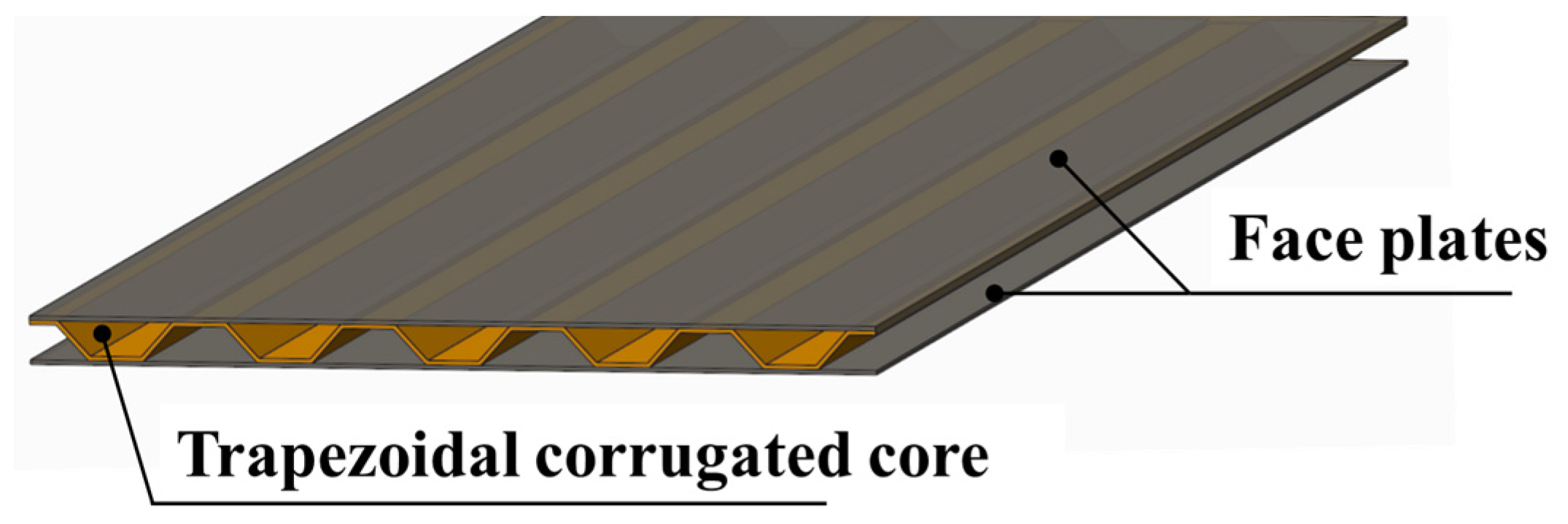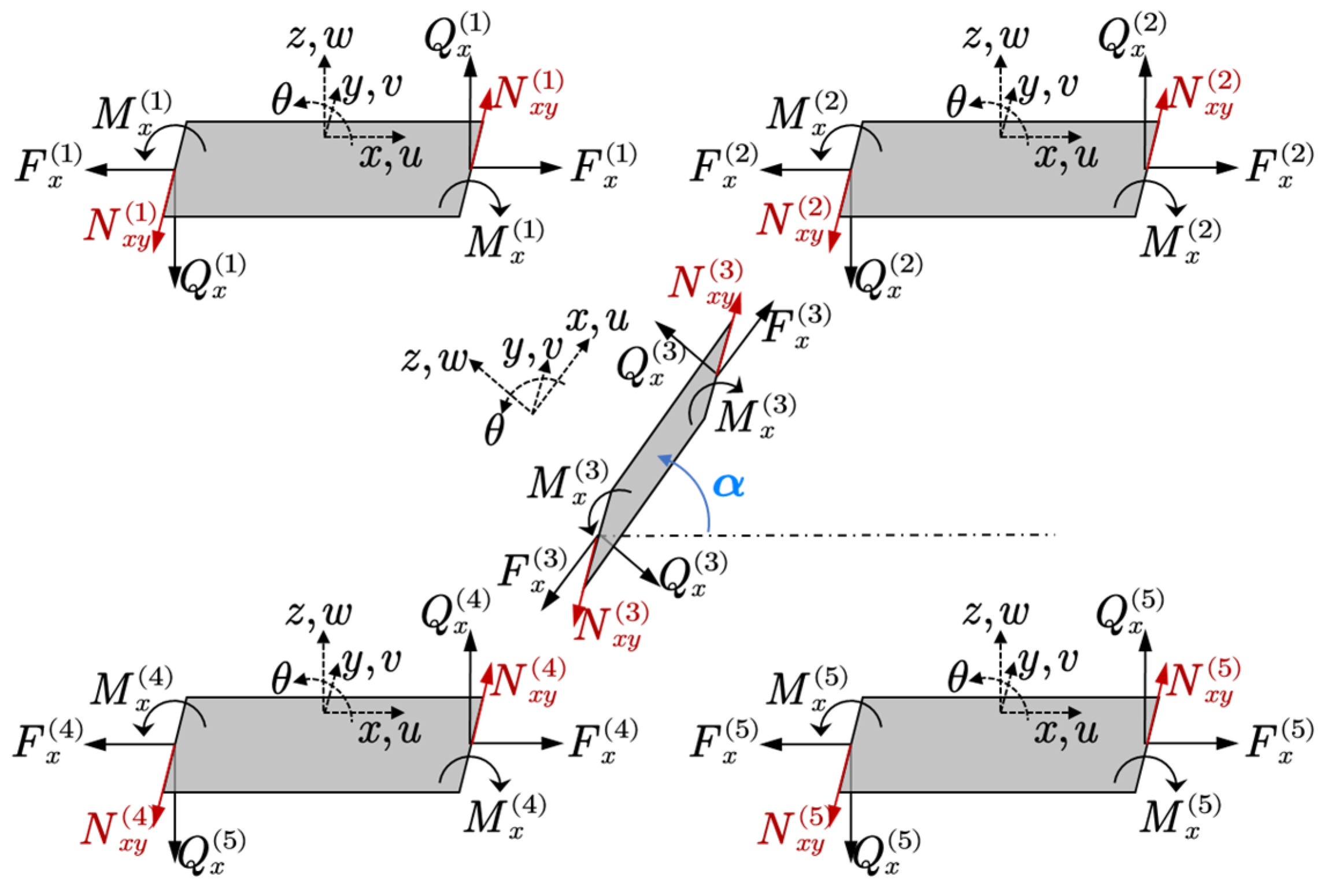2.2. Theoretical Formulation
Considering the periodical one-way stiffened feature of the corrugated core, the sandwich panel studied in this paper is assumed to have an infinite length in the reinforced direction [
28]. As a result, the dynamic response of the sandwich panel can be simplified into a plane strain problem, and only the cross section of the sandwich structure is considered.
In terms of structure, the sandwich panel can be treated as an assembly of several single panel, as shown in
Figure 3.
According to the Kirchhoff theory [
29] and Navier equations [
30], the governing equations of the free transverse and longitudinal vibration of a thin panel can be expressed as
where
is the transverse displacement, and
is the longitudinal displacement.
In addition,
where
is the Poisson’s ratio, and
and
are the material density and thickness of the panel, respectively. Associating with the elasticity modulus
, in order to consider the material damping, the damping factor
is added and leads to a complex elasticity modulus
.
With the assumption of infinite length, as shown in
Figure 4, Equation (1) degenerate to
where
is the local coordinate of the panel, and
where
and
are the bending and longitudinal wave number, respectively.
For the structural part, since the sandwich structure is an assembly of several single plates and both the transverse and longitudinal displacements are expressed by the summation of corresponding wave functions, the governing equations of the whole structure can be assembled based on the displacement compatibility conditions and force equilibrium conditions. A demonstration of the connection relations between five sub-plates is shown in
Figure 5. According to the force–displacement relation, all the internal forces can be calculated by using the following relations:
As for the acoustic cavity, the governing equation of the sound pressure inside is the Helmholtz equation [
24]:
where
is the sound speed inside the acoustic cavity, and
is the acoustic wave number. According to the basic concept of the WBM, both the structural displacement and sound pressure can be approximated by a summation of the specific wave functions [
22].
where
and
are the structural wave functions, which are also the exact solution of Equation (1).
is the acoustic wave function contribution coefficient, and
and
are the structural wave function contribution coefficients.
is the particular solution of the nonhomogeneous Helmholtz equation.
Since there is a direct coupling between the acoustic cavity and structure, represent the particular solution induced by the sound pressure inside the cavity. The additional terms, and , are the particular solution caused by the existence of external excitation and acoustic source, respectively.
For the acoustic cavity,
is the acoustic wave function, which satisfies the Helmholtz equation and is defined as:
Due to the irregularity of the acoustic cavity, the wave functions are defined in the envelope rectangle shown in
Figure 6.
Corresponding to each acoustic wave function, the cavity sound pressure induced transverse displacement of the plate can be expressed as
where
When the panel is subjected to a concentrated point force
, the particular solution is [
31]
In this paper, because the sandwich panel is subjected to the acoustic plane wave excitation, as shown in
Figure 7, the particular solution for a single flat panel can be expressed as follows [
31]:
Since there are direct couplings between the sandwich structure and the interior acoustic cavities,
Figure 8 gives a simple demonstration of a panel–cavity coupled system which consists of two adjacent sub-domains
and
.
Take sub-domain
as an example, to enforce the boundary condition, a weighted residual formulation is used.
In this sub-domain, there are five kinds of boundary condition:
is the particle velocity boundary condition (including acoustic rigid wall),
is the sound pressure boundary condition,
is the acoustic impedance boundary condition,
is the vibro-acoustic coupling boundary condition, and
is the acoustic continuity boundary condition. On each kind of boundary, the residual function is defined as
The linear differential operator
is defined as
where
is the density of the acoustic medium. According to the conventional Galerkin procedure, the weighted function can also be written as a summation of the same acoustic wave function given in Equation (10):
Substituting Equations (7) and (19) into the boundary weighted residual formulation (17) leads to the linear equations of the acoustic cavity:
where
where
and
are the total number of acoustic cavities and sub-plates,
is the boundary condition matrix,
is the vibro-acoustic coupling matrix, and
is the coupling matrix between adjacent acoustic cavities; the details of those matrices are given in
Appendix A. Assuming the total number of acoustic wave functions is
,
is a
vector related to the predefined boundary conditions, and the detailed formulation can also be found in the
Appendix. To balance the computational efficiency and accuracy, the number of acoustic wave functions can be determined by using the structural bending wave number:
Associating with the structural boundary condition, the dynamic equations of the structural part of the system can also be written in a simple matrix form:
where
The sub-matrices
,
and
are the vibro-acoustical coupling matrix, structural bending coefficient matrix, and structural in-plane coefficient matrix, respectively. Thus, the complete form of the governing equation of the system can be written as
As the key indicator of evaluating the sound insulation performance of the sandwich panel, the sound transmission loss (STL) is used to be the objective of the optimization procedure:
where
and
are the incident and radiation sound power, respectively.
As shown in
Figure 9, the external excitation is incident plane sound wave with an angle of α. The radiation sound pressure can be calculated by using the Raleigh’s integral [
32]:
where:
is the density of the acoustic medium,
is the Hankel function of the second kind,
is the radius of the half-circle observation surface,
is the normal velocity, and
is the wave number of the acoustic wave.
Thus, the radiation sound power can be obtained as follows:
Since the sound transmission loss of the sandwich panel varies with the target frequency, in order to evaluate the sound insulation performance in a specific frequency range
, the frequency averaged STL used in the optimization process:
2.3. Numerical Verification
Consider a unit cell of the sandwich plate with corrugated core, as shown in
Figure 10, the total length of the structure is
L = 0.5 m, the distance between the top face sheet and bottom face sheet is
H = 0.15 m, the inclined angle of the core plate α = 60°. The two face plates and the core sheet have the same thickness, which is
ht =
hb =
hs = 2 mm.
This vibro-acoustic coupling system contains three trapezoidal acoustic cavities, which are filled with air. Each acoustic cavity is coupled with the plates occupying its boundaries. Both structural ends of the unit cell are clamped, and the left and right end boundaries of the acoustic cavity are considered as acoustically rigid wall. Assuming there is a uniformly distributed pressure p with an unit magnitude acting on the bottom sheet, to verify the reliability and computational efficiency of the wave-based method, both the conventional finite element method (ANSYS®) and the WBM are used to calculate the vibro-acoustic response of the system.
Figure 11 presents the displacement response of two observation points on the top face sheet in the frequency range of 1–800 Hz.
Accordingly,
Figure 12 gives the sound pressure distribution of the acoustic cavities at the resonance frequencies marked in
Figure 11.
Both the structural displacement response and the in-cavity sound pressure distribution indicate that the result obtained by the WBM agrees very well with the conventional finite element method. Especially for the in-cavity sound pressure response, not only the pressure distribution but also the magnitude has a great match with the FEM commercial software.
The comparison between the conventional FEM and the present method proves the reliability of the WBM. According to the truncation rules of the WBM, the total number of basic wave functions used to approximate the field variables are related to the plate bending wavelength, which means the number of wave functions would become larger when the targeting frequency increasing.
As shown in
Figure 13, both the number of wave functions and computational central processing unit (CPU) time are proportional to the frequency. Moreover, since the WBM is frequency-dependent, the system equation should be reconstructed in each frequency step, which costs most of the computational time. Nonetheless, at the highest frequency, 800 Hz, the total DOFs of the system is 127, which is still much smaller than the conventional FEM.
Figure 14 presents the frequency average CPU time of the present method, and FEM, the relative error between the two methods, is represented by red square dots.
For FEM, the comparison result indicates that with the increase of the mesh number per wavelength, the system DOFs is strikingly enlarged, and the computational accuracy is significantly improved. From the perspective of relative error, because of the analytical nature of the WBM, the result of the FEM would converge to the result of the WMB. When the relative error reduces to less than 5%, the average CPU time of FEM is 5.4 s, which is almost seven times that of the present method.
According to the validation results presented above, the WBM is reliable in solving the dynamic response of the vibro-acoustic coupling system and has much higher computational efficiency than the conventional FEM. Those advantages make the WBM a good choice for the vibro-acoustic optimization procedure, which usually requires enormous computation.











































